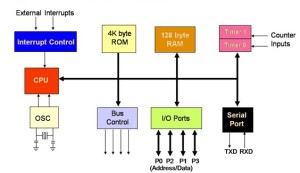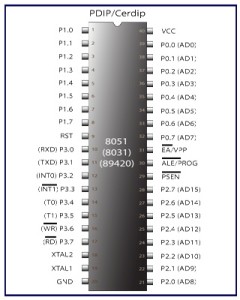Sphoorthy Engineering College
Monday 27 October 2014
8051 Microcontroller Architecture
The 8051 Microcontroller was designed in 1980’s by Intel. Its foundation was on Harvard Architecture and was developed principally for bringing into play in Embedded Systems. At first it was created by means of NMOS technology but as NMOS technology needs more power to function therefore Intel re-intended Microcontroller 8051 employing CMOS technology and a new edition came into existence with a letter ‘C’ in the title name, for illustration: 8051. These most modern Microcontrollers need fewer amount of power to function in comparison to their forerunners.
There are two buses in 8051 Microcontroller one for program and other for data. As a result, it has two storage rooms for both program and data of 64K by 8 size. The microcontroller comprise of 8 bit accumulator & 8 bit processing unit. It also consists of 8 bit B register as majorly functioning blocks and 8051 microcontroller programming is done with embedded C language using Keil software. It also has a number of other 8 bit and 16 bit registers.
For internal functioning & processing Microcontroller 8051 comes with integrated built-in RAM. This is prime memory and is employed for storing temporary data. It is unpredictable memory i.e. its data can get be lost when the power supply to the Microcontroller switched OFF.
8051 Microcontroller Architecture:
Microcontroller 8051 block diagram is shown below. Let’s have a closer look on features of 8051 microcontroller design:

Block Diagram of 8051 Microcontroller
CPU (Central Processor Unit):
As you may be familiar that Central Processor Unit or CPU is the mind of any processing machine. It scrutinizes and manages all processes that are carried out in the Microcontroller. User has no power over the functioning of CPU. It interprets program printed in storage space (ROM) and carries out all of them and do the projected duty. CPU manages different types of registers in 8051 microcontroller.
Interrupts:
As the heading put forward, Interrupt is a sub-routine call that reads the Microcontroller’s key function or job and helps it to perform some other program which is extra important at that point of time. The characteristic of 8051 Interrupt is extremely constructive as it aids in emergency cases. Interrupts provides us a method to postpone or delay the current process, carry out a sub-routine task and then all over again restart standard program implementation.
The Micro-controller 8051 can be assembled in such a manner that it momentarily stops or break the core program at the happening of interrupt. When sub-routine task is finished then the implementation of core program initiates automatically as usual. There are 5 interrupt supplies in 8051 Microcontroller, two out of five are peripheral interrupts, two are timer interrupts and one is serial port interrupt.
Memory:
Micro-controller needs a program which is a set of commands. This program enlightens Microcontroller to perform precise tasks. These programs need a storage space on which they can be accumulated and interpret by Microcontroller to act upon any specific process. The memory which is brought into play to accumulate the program of Microcontroller is recognized as Program memory or code memory. In common language it’s also known as Read Only Memory or ROM.
Micro-controller also needs a memory to amass data or operands for the short term. The storage space which is employed to momentarily data storage for functioning is acknowledged as Data Memory and we employ Random Access Memory or RAM for this principle reason. Microcontroller 8051 contains code memory or program memory 4K so that is has 4KB Rom and it also comprise of data memory (RAM) of 128 bytes.
Bus:
Fundamentally Bus is a group of wires which functions as a communication canal or mean for the transfer Data. These buses comprise of 8, 16 or more cables. As a result, a bus can bear 8 bits, 16 bits all together. There are two types of buses:
- Address Bus: Microcontroller 8051 consists of 16 bit address bus. It is brought into play to address memory positions. It is also utilized to transmit the address from Central Processing Unit to Memory.
- Data Bus: Microcontroller 8051 comprise of 8 bits data bus. It is employed to cart data.
Oscillator:
As we all make out that Microcontroller is a digital circuit piece of equipment, thus it needs timer for its function. For this function, Microcontroller 8051 consists of an on-chip oscillator which toils as a time source for CPU (Central Processing Unit). As the productivity thumps of oscillator are steady as a result, it facilitates harmonized employment of all pieces of 8051 Microcontroller. Input/output Port: As we are acquainted with that Microcontroller is employed in embedded systems to manage the functions of devices.
Thus to gather it to other machinery, gadgets or peripherals we need I/O (input/output) interfacing ports in Micro-controller. For this function Micro-controller 8051 consists of 4 input/output ports to unite it to other peripherals.Timers/Counters: Micro-controller 8051 is incorporated with two 16 bit counters & timers. The counters are separated into 8 bit registers. The timers are utilized for measuring the intervals, to find out pulse width etc.
8051 Microcontroller Pin Diagram

8051 Microcontroller Pin Diagram
For explaining the pin diagram and pin configuration of microcontroller 8051, we are taking into deliberation a 40 pin Dual inline package (DIP). Now let’s study through pin configuration in brief:-
Pins 1 – 8:- recognized as Port 1. Different from other ports, this port doesn’t provide any other purpose. Port 1 is a domestically pulled up, quasi bi directional Input/output port.
Pin 9:- As made clear previously RESET pin is utilized to set the micro-controller 8051 to its primary values, whereas the micro-controller is functioning or at the early beginning of application. The RESET pin has to be set elevated for two machine rotations.
Pins 10 – 17:- recognized as Port 3. This port also supplies a number of other functions such as timer input, interrupts, serial communication indicators TxD & RxD, control indicators for outside memory interfacing WR & RD, etc. This is a domestic pull up port with quasi bi directional port within.
Pins 18 and 19:- These are employed for interfacing an outer crystal to give system clock.
Pin 20:- Titled as Vss – it symbolizes ground (0 V) association.
Pins- 21-28:- recognized as Port 2 (P 2.0 – P 2.7) – other than serving as Input/output port, senior order address bus indicators are multiplexed with this quasi bi directional port.
Pin- 29:- Program Store Enable or PSEN is employed to interpret sign from outer program memory.
Pin-30:- External Access or EA input is employed to permit or prohibit outer memory interfacing. If there is no outer memory need, this pin is dragged high by linking it to Vcc.
Pin-31:- Aka Address Latch Enable or ALE is brought into play to de-multiplex the address data indication of port 0 (for outer memory interfacing). Two ALE throbs are obtainable for every machine rotation.
Pins 32-39: recognized as Port 0 (P0.0 to P0.7) – other than serving as Input/output port, low order data & address bus signals are multiplexed with this port (to provide the use of outer memory interfacing). This pin is a bi directional Input/output port (the single one in microcontroller 8051) and outer pull up resistors are necessary to utilize this port as Input/output.
Pin-40: termed as Vcc is the chief power supply. By and large it is +5V DC.
Applications of 8051 Microcontroller:
The microcontroller 8051 applications include large amount of machines, principally because it is simple to incorporate in a project or to assemble a machine around it. The following are the key spots of spotlight:

Applications of 8051 microcontroller
- Energy Management: Competent measuring device systems aid in calculating energy consumption in domestic and industrialized applications. These meter systems are prepared competent by integrating microcontrollers.
- Touch screens: A high degree of microcontroller suppliers integrate touch sensing abilities in their designs. Transportable devices such as media players, gaming devices & cell phones are some illustrations of micro-controller integrated with touch sensing screens.
- Automobiles: The microcontroller 8051 discovers broad recognition in supplying automobile solutions. They are extensively utilized in hybrid motor vehicles to control engine variations. In addition, works such as cruise power and anti-brake mechanism has created it more capable with the amalgamation of micro-controllers.
- Medical Devices: Handy medicinal gadgets such as glucose & blood pressure monitors bring into play micro-controllers, to put on view the measurements, as a result, offering higher dependability in giving correct medical results.
- Medical Devices: Handy medicinal gadgets such as glucose & blood pressure monitors bring into play micro-controllers, to put on view the measurements, as a result, offering higher dependability in giving correct medical results.
Article by
................
ECE Department
................
ECE Department
C Language Basics
C Language Basics
C is a general-purpose high level language that was originally developed by Dennis Ritchie for the Unix operating system. It was first implemented on the Digital Eqquipment Corporation PDP-11 computer in 1972.
The Unix operating system and virtually all Unix applications are written in the C language. C has now become a widely used professional language for various reasons.
- Easy to learn
- Structured language
- It produces efficient programs.
- It can handle low-level activities.
- It can be compiled on a variety of computers.
Facts about C
- C was invented to write an operating system called UNIX.
- C is a successor of B language which was introduced around 1970
- The language was formalized in 1988 by the American National Standard Institue (ANSI).
- By 1973 UNIX OS almost totally written in C.
- Today C is the most widely used System Programming Language.
- Most of the state of the art software have been implemented using C
Why to use C ?
C was initially used for system development work, in particular the programs that make-up the operating system. C was adoped as a system development language because it produces code that runs nearly as fast as code written in assembly language. Some examples of the use of C might be:
- Operating Systems
- Language Compilers
- Assemblers
- Text Editors
- Print Spoolers
- Network Drivers
- Modern Programs
- Data Bases
- Language Interpreters
- Utilities
C Program File
All the C programs are writen into text files with extension ".c" for example hello.c. You can use "vi" editor to write your C program into a file.
This tutorial assumes that you know how to edit a text file and how to write programming insturctions inside a program file.
C Compilers
When you write any program in C language then to run that program you need to compile that program using a C Compiler which converts your program into a language understandable by a computer. This is called machine language (ie. binary format). So before proceeding, make sure you have C Compiler available at your computer. It comes alongwith all flavors of Unix and Linux.
If you are working over Unix or Linux then you can type gcc -v or cc -v and check the result. You can ask your system administrator or you can take help from anyone to identify an available C Compiler at your computer.
If you don't have C compiler installed at your computer then you can use below given link to download a GNU C Compiler and use it.
Article by
----------------
CSE Department
Sphoorthy Engineering College
 |
| Sphoorthy Engineering College |
Subscribe to:
Posts (Atom)


